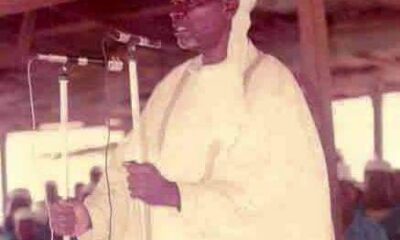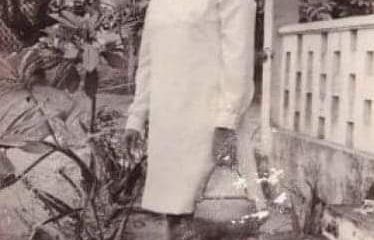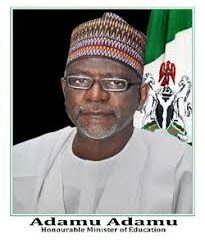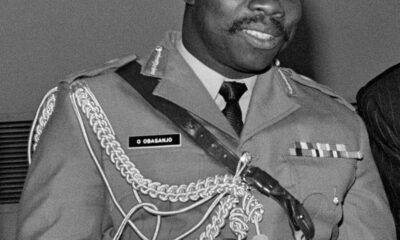Opinion
Khalifa Muhammadu Sanusi II, A Phoenix Rises
Opinion
Annual Malaria Scourge: Call for Pro-active Actions
By Sani Surajo Abubakar
According to the World Health Organization (WHO), malaria is a disease caused by Parasite that spread to humans through the bites of infected mosquitoes. People who have malaria, usually feel very sick with high fever and shaking chills.
As fever may means symptom of many ailments, most a times malaria comes with; fever, chills, general feeling of discomfort, headache, diarrhea, abdominal pain, muscle or joint pain, fatigue, rapid breathing, rapid heart rate, cough as symptoms that may begin few weeks after infection.
WHO 2023 World Malaria report identifies Malaria as one of the most severe public health problems worldwide. It is a leading cause of death and a disease in many developing countries where young children and pregnant women are the most affected.
The report elucidated further that nearly half of the world population lives in the areas at risk of Malaria transmission in 85 countries and territories.
The 2022 WHO malaria report shows that Nigeria has the highest burden of malaria globally, accounting for nearly 27% global burden as it is the major public health concern in the country with an estimated 68 million cases and 194,000 deaths due to the disease in 2021.
On April 25th this year, while addressing a press conference on World Malaria day, Kano State Commissioner of Health, Dr. Abubakar Labaran Yusuf said, ‘in Kano, it’s recorded that malaria is the single most common reason for about 60 percent of outpatient visits and consultations. It is estimated that in the year 2023 alone, more than 3.2 million hospital visits were due to the menace of malaria which is a preventable disease
In the year 2023, the outpatient attendance relating to malarial cases was 3,435,750 with total fever cases screened for malaria recorded at 3,247,651, and 2,348,264 confirmed to have malaria. Meanwhile, 448 mortality was recorded’. added Commissioner Labaran.
In what seems like an annual scourge, many states in the country, Kano included do experience hundreds of thousands of malaria cases mostly occasioned by the rainy season and aggravated by other factors.
The piece intends to offer some suggestions to avoid the recurrence or reduce to the bearest minimum the severity of the annual pandemic in view of its negative consequence on the socio-economic well-being of people and the burden of its management on the concerned authority.
First and foremost, governments must intensify awareness campaigns via the conventional, social media platforms and any available medium on the need for the public to adopt preventive measures of contacting disease. This will greatly be impacted in reducing hospitals visitations, save- out- of- pocket spending and reduce the pressure on health facilities with minimal government’s commitment in managing the burden.
Secondly, authority concern should provide enough testing equipment and drugs especially at rural areas where there are scarce health facilities. If possible, door-to-door testing and treatment need to be initiated and implement to assist those in need.
Furthermore, governments at all levels in collaboration with Non-governmental Organizations, philanthropists and donor organizations should provide long lasting treated mosquito nets (LLTN) and distribute free to people living in the prone areas especially in the rural communities.
Also, to avert or minimize the recurrence of malaria cases, concerted efforts needs to be made to clear drainages and made places of works, residences not harboring stagnant water. By so doing, the breeding of mosquito larvae is avoided.
On the other hand, to complement what governments did, members of the public too needs to reciprocate and do their own part to achieve the objective of keeping malaria cases at bay and improve healthy living.
One of such things to do is people should be aware and always seeks to know malaria symptoms. Despite the fact that medical experts had identified many of its symptoms, yet people should be aware of the common symptoms for early diagnosis and treatment.in this respect test is a very paramount as Rapid Diagnostic Teste (RDT) is cheaply available for detection of malaria.
In addition, agencies responsible for refuse evacuation and environmental sanitation in towns and cities should fumigate areas prone to harbor mosquitoes, this will pave way to have safer habitat convenient for safer habitation and free from diseases.
Those with symptoms should visit the nearest health facility for diagnosis and treatment. Those diagnosed should adhere to medical procedure and prescription and ensure completion of the treatment plan. It is on record that many patients experienced relapse of malaria by failing to complete treatment prescribed at the onset of the disease.
People needs also to seek for medical intervention at early stage and ensure procurement of standard medication. At this juncture, it is of paramount to make a clarion call to governments to provide free complete malaria treatment to all citizens.
Where residents became recalcitrant in disobeying sanitation rules and regulations, stiffer punishment must be meted to those who build and dump refuse on waterways and also fail to clean their environments or exhibit attitudes detrimental to healthy environments.
People must also develop the habit of sleeping under mosquito treated nets (LLTN) always. This is proved to be one of the cheaper, and simple method of avoiding contracting malaria.
With concerted efforts of all the stakeholders in containing the annual scourge of malaria, surely positive results will be achieved at the end and wipe out or minimize to bearest minimum of the disease and enjoy healthy living by people.
A stich in time save nine.
Sani is an Assistant Chief Information Officer, Government House, Kano
Opinion
The Benefit of State Creation, By Adnan Mukhtar
On July 11, the Senator representing Kano South Sulaiman Abdulrahman Kawu Sumaila sponsored a bill for the creation of a new state, Tiga State.
This is not the first time that people from different parts of the country are agitating for the creation of new states in their region.
The call for the creation of Tiga State didn’t start today ,During the regime of Late General Sani Abacha the creation of Tiga state gatheres momentum ,Insiders in the Presidential Villa confirmed that General Abacha have already made up his mind to carve out Tiga state from the present Kano state but due reasons best known to him the Late Head of state announced the creation of Zamfara state from the Northwest on 1st October 1996,even with that the agitation did n not die down , I came across agitators for Tigari State from Kano North and Tiga from Kano South while in Secondary school during the administration of Chief Olusegun Obasanjo.
Ned Nwoko, a Senator from Delta State sponsored a similar bill for the creation of Anioma State.
Young men like me who are in their early 30s and not current with issues in the country may think that the recent move by Senator Sumaila was the first of its kind.
There were similar requests for the creation of Okura state out of Kogi, Aba from Abia, Hadeija from Jigawa, Katagum from Bauchi, Karadua and Kafur from Katsina, Lagoon from Lagos, Borgu, Kainji and Gurara from Niger and many more.
In 2013, the House of Representatives received more than 50 requests for the creation of new states.
The creation of states began in 1967 when General Yakubu Gowon created 12 states after abolishing the regional system, General Murtala Mohammed 7 states, General Ibrahim Babangida created 11 states between 1987 to 1991 and General Sani Abacha created 6 states.
Some young men on social media were criticising the move by the Senator by expressing their pessimistic thoughts that the bill may not scale a second reading or get the assent of the President. They argued that such requests had never given any priority since the return to democracy 25 years ago. The idea of creating more states is dead on arrival.
Some are of the view that such moves require a very long process because constitutional amendment in the country is a very difficult thing.
While states in the country relied on federal allocation to survive, they can’t pay salaries and their internally generated revenue has been very poor; the creation of additional states is adding a burden to the Federal government at this time of economic instability.
Nigerians are facing the most difficult economic condition under President Tinubu. Sadly, the President doesn’t care to address this critical issue by going ahead to purchase a presidential aircraft that’s worth 150 billion dollars although the president has yet to increase the minimum wage, long queues at the filling stations, a bag of rice is close to 100k with a 30k minimum wage; I wonder whether the president is serious enough in attending to this matter of National concern.
Some of the agitators of this are seeking the expansion of platforms for their citizens to utilise their potential under a federal system of government.
It was not a wrong thing to come up with this idea but a constitutional right. I’m sure most of these agitators and bill sponsors are speaking the minds of their people.
Some people are accusing Sumaila of trying to divide the people of Kano. These sets of people are deceiving themselves. The people of Kano South have been crying about marginalisation and being denied the dividends of democracy since 2011.
Abubakar Rimi was from Sumaila in Kano South, he governed Kano in the second republic. Kabiru Gaya governed Kano in 1993 and since then, the people of this zone are yet to be given any chance to govern Kano.
They have also been crying that most of the developmental and infrastructural projects are been centred in Kano Central while abandoning the rural areas.
State creation in states like Kano with 44 local governments will enhance development and bring government closer to the people.
While I support the idea of having more states like in the US, we should put this at the back of our mind states are building blocks for development in the Federal system of government and will boost democratic governance.
Adnan is a political PR consultant, he teaches Islamic History, Culture and Civilization at Federal University Dutsin-Ma. He can be reached at adnanmukhtaradam@gmail.com
Opinion
The Political Motivations Behind Nigerian State Creation: A Historical Analysis
Abdullahi Dahiru
Many proponents of state creation believe that Nigerian states were created for progress and development but history tells us otherwise.
Sarkin Kano Sir Muhammad Sanusi had dispute with the then Northern regional government leading him to abdicate the throne in 1963. Many Kano people were angry with the way the Northern regional government treated Sarki Sanusi and decided to form a pressure group called Kano Peoples’ Party, KPP. KPP agitated for creation of Kano state out of the then Northern region because many Kano people believe the regional government unfairly treated Kano province even though the province contributed revenue to the regional government more than any other province. KPP also agitated for the reinstallation of Sarki Sanusi as the Emir of Kano.
After 1966 military coup, there was tension between the Eastern region and the central government. The governor of the then Eastern region Odumegwu Ojukwu decided to secede from Nigeria to form an independent nation of Biafra. Just 3 days before Ojukwu’s decleration of independence, the head of state Yakubu Gowon abolished the regional governments and created 12 new states. The purpose of the state creation by Gowon was to reduce the power of Ojukwu and get the support of minorities and other sections of the country. Kano province was among the new states created as Kano state partly fulfilling the wishes of the KPP.
State creation became an important aspect of military rule. Murtala regime created seven more states bringing the total number of states to 19. In 1987, Babangida’s political bureau recommended creation of two additional states to make the total number of states divisible by three, so as to get a perfect number when 2/3 of states is being computed to determine the winner of presidential election. This was to prevent the recurrence of dispute of 1979 election about what is the 2/3 of 19 states. So Babangida created Katsina and Akwai Ibom states in 1987.
Babangida and Abacha created more states in 1991 and 1996 bringing the total number of states to 36. The 1991 and 1996 exercises were done when there were pressures for Babangida and Abacha to handover power to civilians.
During the military regions committees were formed to recommend states to be created when there were plans to do those exercises. The committees receive requests from different groups for creation of states but the ultimate decision was done by the military council. The military do that often to satisfy lobbies from high ranking military officers and powerful Nigerians. It is often not about the people or development.
State creation was easy under miltary regimes since the constitution is usually suspended. A sole administrator is posted to the new state and take up grant given by government. That is very difficult in civilian administrations because of many bottle necks.
Whoever analyses the history of state creation in Nigeria he will know that it is almost exclusively done by military regimes and it is not something done for development or anything but political expediency. The most economically viable Nigerian state has remain a single state since 1967. Civilian administrations have tried several times to create new states without success. Many states that were created are surviving only because of monthly revenue allocation from the Federal Government. Without that federal allocation, they are nothing.
-

 Features3 years ago
Features3 years agoHow I Became A Multimillionaire In Nigeria – Hadiza Gabon
-

 Opinion2 years ago
Opinion2 years agoOn The Kano Flyovers And Public Perception
-

 History3 years ago
History3 years agoSheikh Adam Abdullahi Al-Ilory (1917-1992):Nigeria’s Islamic Scholar Who Wrote Over 100 Books And Journals
-

 Opinion4 years ago
Opinion4 years agoKano As future Headquarters Of Poverty In Nigeria
-

 History3 years ago
History3 years agoThe Origin Of “Mammy Market” In Army Barracks (Mammy Ochefu)
-

 News2 years ago
News2 years agoFederal University Of Technology Babura To Commence Academic Activities September
-

 Opinion3 years ago
Opinion3 years agoMy First Encounter with Nasiru Gawuna, the Humble Deputy Governor
-

 History4 years ago
History4 years agoObasanjo Was appointed Head Of State Against His Wish